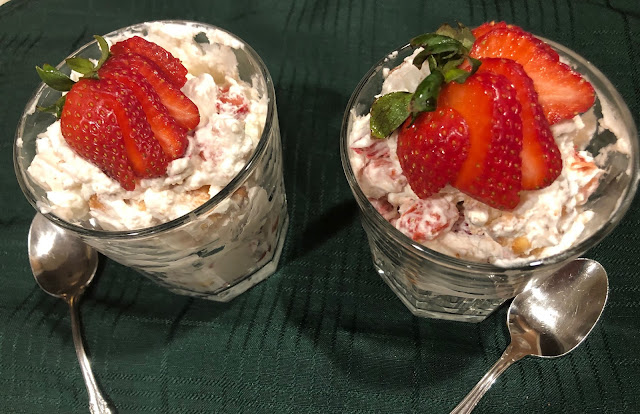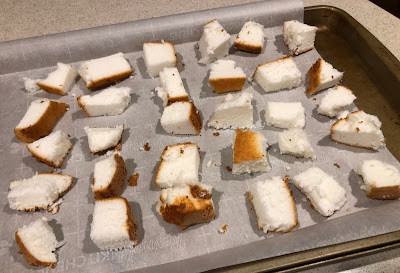
Recipe: Strawberries star in no-fuss dessert
 |
|
A strawberry fan tops off the strawberry-cream-cake dessert. (Photos:
Kathy Morrison)
|
The British dessert known as Eton mess has been on my dessert bucket list for awhile. It's named for Eton College, where the sweet creation is served after the traditional Eton-Harrow cricket match. Fresh strawberries are the stars, diced and allowed to macerate in a little sugar. They're swirled into a concoction of fresh whipped cream and broken pieces of crunchy meringue. Sounds like spring, right?
(The origin of the dessert isn't clear, but it seems likely that a dessert accident -- maybe dropped? crushed? sat on? -- was a contributing factor. The dessert called pavlova, after the celebrated Russian ballerina, also has meringue, cream and fruit, and may have been the starting point.)
 |
|
The angel food cake slices were cut into chunks. After trying
varied sizes, I decided smaller was better: more crunch.
|
Well, I didn't feel like making my own meringues -- I had gardening to do! -- and I couldn't find any meringue cookies in my COVID-limited sphere. So I went with the next best thing: toasted pieces of an angel food cake I'd found in the supermarket bakery department. That'd be crunchy, sweet and airy, right? So I had to rename the dessert.
I also picked up a few tips along the way about the ingredients, which can come across as too sweet without something to cut through the sugar. Lemon zest and just a bit of mascarpone cheese (or sour cream, crème fraîche or plain yogurt) do just that.
Raspberries or blackberries also would be delicious in this, though you'd have to crush them a bit to get some juice going. (Lime zest instead of lemon works best for these berries.) This recipe will serve 4 easily -- 6 after a big dinner, since it's surprisingly rich.
Don't mix the prepared ingredients together until just before serving or the toasted cake will get soft. Then you'd have something approaching trifle, which is another spring dessert altogether!
Strawberry Angel's Mess
Serves 4-6
Ingredients:
 |
|
The ingredients are all prepped and ready to combine. I decided
later that more strawberries than I have here would be better,
so the recipe reflects that.
|
Comments
0 comments have been posted.Sacramento Digs Gardening to your inbox.
Food in My Back Yard Series
May 6: Maintain soil moisture with mulch for garden success
April 29: What's (already) wrong with my tomato plants?
April 22: Should you stock up on fertilizer? (Yes!)
April 15: Grow culinary herbs in containers
April 8: When to plant summer vegetables
April 1: Don't be fooled by these garden myths
March 25: Fertilizer tips: How to 'feed' your vegetables for healthy growth
March 18: Time to give vegetable seedlings some more space
March 11: Ways to win the fight against weeds
March 4: Potatoes from the garden
Feb. 25: Plant a fruit tree now -- for later
Feb. 18: How to squeeze more food into less space
Feb. 11: When to plant? Consider staggering your transplants
Feb. 4: Starting in seed starting
Sites We Like
Garden Checklist for week of May 11
Make the most of the lower temperatures early in the week. We’ll be back in the 80s by Thursday.
* Plant, plant, plant! It’s prime planting season in the Sacramento area. Time to set out those tomato transplants along with peppers and eggplants. Pinch off any flowers on new transplants to make them concentrate on establishing roots instead of setting premature fruit.
* Direct-seed melons, cucumbers, summer squash, corn, radishes, pumpkins and annual herbs such as basil.
* Harvest cabbage, lettuce, peas and green onions.
* In the flower garden, direct-seed sunflowers, cosmos, salvia, zinnias, marigolds, celosia and asters. (You also can transplant seedlings for many of the same flowers.)
* Plant dahlia tubers.
* Transplant petunias, marigolds and perennial flowers such as astilbe, columbine, coneflowers, coreopsis, dahlias, rudbeckia and verbena.
* Keep an eye out for slugs, snails, earwigs and aphids that want to dine on tender new growth.
* Feed summer bloomers with a balanced fertilizer.
* For continued bloom, cut off spent flowers on roses as well as other flowering plants.
* Add mulch to the garden to maintain moisture. Mulch also cuts down on weeds. But don’t let it mound around the stems or trunks of trees or shrubs. Leave about a 6-inch-to-1-foot circle to avoid crown rot or other problems.
* Remember to weed! Pull those nasties before they set seed.
* Water early in the day and keep seedlings evenly moist.